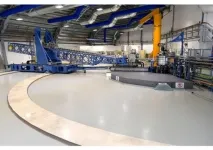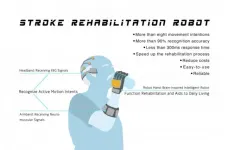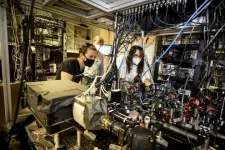Seeing with radio waves
Researchers at the University of Tsukuba use radio-frequency waves to image "spin-locked" defects in diamond with record-breaking resolution, which may lead to advances in material characterization and quantum computing
2021-07-09
(Press-News.org) Tsukuba, Japan - Scientists from the Division of Physics at the University of Tsukuba used the quantum effect called "spin-locking" to significantly enhance the resolution when performing radio-frequency imaging of nitrogen-vacancy defects in diamond. This work may lead to faster and more accurate material analysis, as well as a path towards practical quantum computers.
Nitrogen-vacancy (NV) centers have long been studied for their potential use in quantum computers. A NV center is a type of defect in the lattice of a diamond, in which two adjacent carbon atoms have been replaced with a nitrogen atom and a void. This leaves an unpaired electron, which can be detected using radio-frequency waves, because its probability of emitting a photon depends on its spin state. However, the spatial resolution of radio wave detection using conventional radio-frequency techniques has remained less than optimal.
Now, researchers at the University of Tsukuba have pushed the resolution to its limit by employing a technique called "spin-locking." Microwave pulses are used to put the electron's spin in a quantum superposition of up and down simultaneously. Then, a driving electromagnetic field causes the direction of the spin to precess around, like a wobbling top. The end result is an electron spin that is shielded from random noise but strongly coupled to the detection equipment. "Spin-locking ensures high accuracy and sensitivity of the electromagnetic field imaging," first author Professor Shintaro Nomura explains. Due to the high density of NV centers in the diamond samples used, the collective signal they produced could be easily picked up with this method. This permitted the sensing of collections of NV centers at the micrometer scale. "The spatial resolution we obtained with RF imaging was much better than with similar existing methods," Professor Nomura continues, "and it was limited only by the resolution of the optical microscope we used."
The approach demonstrated in this project may be applied in a broad variety of application areas--for example, the characterizations of polar molecules, polymers, and proteins, as well as the characterization of materials. It might also be used in medical applications--for example, as a new way to perform magnetocardiography.
INFORMATION:
The work is published in Journal of Applied Physics as "Near-field radio-frequency imaging by spin-locking with a nitrogen-vacancy spin sensor" selected as a Featured Article (DOI: 10.1063/5.0052161).
This work was partly supported by a Grant-in-Aid for Scientific Research (Nos. JP18H04283,
291 JP18H01243, JP18K18726, and JP21H01009) from the Japan Society for the Promotion of
292 Science.
[Attachments] See images for this press release:

ELSE PRESS RELEASES FROM THIS DATE:
2021-07-09
The discovery of the first high-temperature superconductor in 1986 brought with it the hope that superconductivity would one day revolutionise power transmission, electronic devices and other technologies. Materials that show superconductivity (zero electrical resistance) generally do so at an extremely low temperature. For their use to become widespread and world-changing, we need to develop a material that is superconducting close to room temperature. Research showed that the first high-temperature superconductor - a copper oxide compound - was part of a ...
2021-07-09
Anyone who likes to sing in the shower probably knows that they sometimes sing out of tune. But what about professional singers? How well do they evaluate their own abilities? And what role does this self-assessment play in becoming a better musician? A research team from the Max Planck Institute for Empirical Aesthetics in Frankfurt, New York University, and the University of Hamburg has now investigated these questions scientifically in a study of professional singers.
The study participants, all female sopranos, were each recorded singing "Happy Birthday" in a studio. They were then asked to listen to all of the recordings and rate the pitch accuracy of both their ...
2021-07-09
Babies younger than four weeks old, called neonates, were once thought not to perceive pain due to not-yet-fully-developed sensory systems, but modern research says otherwise, according to researchers from Hiroshima University in Japan.
Not only do babies experience pain, but the various levels can be standardized to help nurses recognize and respond to the babies' cues -- if the nurses have the opportunity to learn the scoring tools and skills needed to react appropriately. With tight schedules and limited in-person courses available, the researchers theorized, virtual e-learning may be able to provide a path forward for nurses to independently pursue training in this area.
To test this hypothesis, researchers conducted a pilot study ...
2021-07-09
Drs. Nobuo Noda (Director) and Tatsuro Maruyama (Researcher) et al. at the Institute of Microbial Chemistry (BIKAKEN, Tokyo, Japan) discovered that lipidated Atg8(1), the most famous factor that mediates autophagy, has membrane perturbation activity and elucidated that this activity is responsible for efficient autophagosome formation.
Autophagosome formation is an essential step in determining the target of degradation in autophagy, which is one of the mechanisms of intracellular protein degradation. It is known that lipidated Atg8 plays a primary role in autophagy processes; however, the molecular function of lipidated Atg8 on the autophagy-related ...
2021-07-09
A new study from Queen Mary University of London has demonstrated that immune cells can be stimulated to assemble into special structures within pancreatic cancer such that, at least in a pre-clinical model, researchers can demonstrate an improvement in the efficacy of chemotherapy.
The body's immune system is a critical defence against illness such as infections, as has been highlighted by the recent COVID-19 pandemic. The same immune system can also help us fight cancer. However, pancreatic cancer is different; a key feature of this cancer type is that the pancreatic cancer cells are surrounded by a dense, impenetrable barrier known as the stroma, which often blocks the access of immune cells to ...
2021-07-09
Coral reefs are a favorite spot for scuba divers and are among the world's most diverse ecosystems. For example, the Hawaiian coral reefs, known as the "rainforests of the sea," host over 7,000 species of marine animals, fishes, birds and plants. But coral reefs are facing serious threats, including a number of diseases that have been linked to human activity.
To understand the connection between human activity and a type of tumorlike disease called growth anomalies (GAs), researchers at the National Institute of Standards and Technology (NIST) have collaborated with the U.S Geological Survey (USGS) and the National ...
2021-07-09
ATLANTA--The American College of Rheumatology (ACR), in partnership with the Vasculitis Foundation (VF), released three new guidelines for the treatment and management of systemic vasculitis. Vasculitis is a group of about 20 rare diseases that have inflammation of blood vessels in common, which can restrict blood flow and damage vital organs. The three guidelines cover six forms of vasculitis, and a fourth guideline on Kawasaki disease will be released in the coming weeks.
"Many rheumatologists may have limited experience caring for patients with these diseases," ...
2021-07-09
Strokes, which occur when the blood supply to part of our brain is interrupted or reduced, are the leading cause of death and disability in the adult population. Among the patients who survive, 75% will experience difficulties carrying out daily activities independently and need long-term functional exercises and rehabilitation. But the outcomes using traditional rehabilitation equipment are poor. In addition, the motivation of patients to train is often low.
The Department of Neurology in Tongji Hospital, which is affiliated to Tongji Medical College at the Huazhong University of Science and Technology, is recognised in China for the quality of its scientific research and clinical strength. Similarly, Zhejiang BrainCo, Ltd., incubated by the Harvard Innovation Lab, is a market ...
2021-07-09
Contrary to conventional thought, songbirds can taste sugar--even though songbirds are the descendants of meat-eating dinosaurs and are missing a key protein that allows humans and many other animals to taste sweetness. An international team investigated how many bird species can taste sweet and how far back that ability evolved. Their work was published today in the journal Science.
The researchers offered two species of songbirds a choice between sugar water and plain water--nectar-taking honeyeaters, as well as canaries, a grain-eating bird not known for consuming sweet foods. They also examined taste receptor responses sampled from a variety of other species. Regardless of whether their main ...
2021-07-09
A team of physicists from the Harvard-MIT Center for Ultracold Atoms and other universities has developed a special type of quantum computer known as a programmable quantum simulator capable of operating with 256 quantum bits, or "qubits."
The system marks a major step toward building large-scale quantum machines that could be used to shed light on a host of complex quantum processes and eventually help bring about real-world breakthroughs in material science, communication technologies, finance, and many other fields, overcoming research hurdles that are beyond the capabilities of even the fastest supercomputers today. Qubits are the fundamental building blocks on which quantum computers ...
LAST 30 PRESS RELEASES:
[Press-News.org] Seeing with radio waves
Researchers at the University of Tsukuba use radio-frequency waves to image "spin-locked" defects in diamond with record-breaking resolution, which may lead to advances in material characterization and quantum computing






